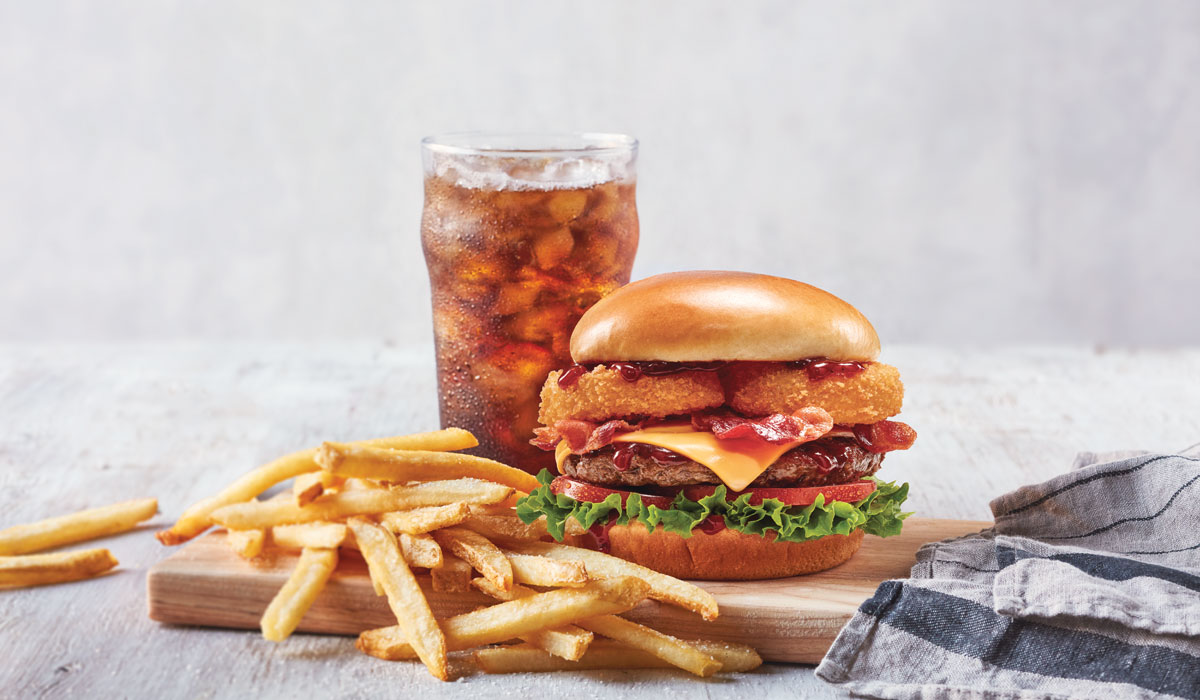Let’s face it. Love or hate IHOP’s IHOb campaign, we all want to know how it fared. Dine Brands’ second-quarter review was the first chance to really get a handle on some of the concrete data behind one of the most buzzed-about promotions in recent history. Darren Rebelez, IHOP’s president, navigated through some other results for IHOP before diving into the promotion. To start, IHOP’s Q2 comps gained 0.7 percent, which was muted but did top Black Box’s 1 percent decline in the family-dining category. The brand also revised its sales guidance to 0.5–2 percent positive from flat to 3 percent for the year.
There’s more to recap but let’s jump right into it. IHOP launched its Ultimate Steakburgers with only three weeks to go in Q2. So this is kind of a narrow recap, although the initial burst is really where the money was.
READ MORE:
We Asked Restaurant Professionals What They Think of IHOb. Here’s What They Said
IHOP’s president explains the daring campaign, and why it worked.
Between June 4—when IHOb became a real thing (kind of)—through the end of June, more than 20,000 stories were written about the name change. The campaign produced more than 36 billion earned media impressions. Social media mentions of IHOP produced a potential reach of more than 4 billion people.
The question asked by many: Did it help sales? Rebelez said, “assisted by the viral impact,” IHOP saw burger sales grow by four times, and have “remained constant since,” driving IHOP’s dinner daypart sales mix by 200 basis points during the first three weeks of the launch. Rebelez also said the marketing campaign and $6.99 deal helped fuel off-premises business. “We’re pleased with the early results and ready to build on this momentum,” he said.
Providing additional color into the method behind the campaign, he said: “When we tested the burgers, the results were very strong, and we achieved a 92 percent intent to repurchase. Once we developed these amazing burgers, we had to generate excitement about them and convey to our guests that we take our burgers just as seriously as we take our pancakes. This was a creative motivation that led to the name change teaser, which I believe is usually successful.”

IHOP was IHOb for a little while. Did it help sales?
On the off-premises topic, to-go sales now account for about 7 percent of total sales, as of the end of Q2. That’s a 150 basis-point increase from the same period last year. IHOP inked a deal with DoorDash in July to bring delivery to more than 300 locations, and expects to have close to 1,000 restaurants on board by the end of the year. IHOP is also testing Amazon and GrubHub and currently has close to 150 restaurants combined providing delivery through those platforms. Overall, to-go comp sales hiked 32 percent during the quarter. To-go traffic grew by 23 percent. Burgers helped the dinner daypart significantly, Rebelez said, which, when you strip back the social media fervor, was really the anchoring purpose of the IHOb launch.
“Last year, we made a concerted effort to begin to change the narrative about IHOP in our lunch and dinner occasions,” Rebelez said. “We knew it would take great food and a bold new approach to grab people’s attention and appetite. Our new lineup of Ultimate Steakburgers did just that.”
IHOP credited its comp gains to lunch and dinner daypart growth, along with off-premises, “and the positive impact from the initial leap of the highly anticipated launch of our all-new Ultimate Steakburgers lineup,” Rebelez said.
IHOP recapped other initiatives. Franchisees completed 58 remodels to the Rise N’ Shine program in the quarter, bringing the total completed this year to about 275 restaurants. Since the inception of the program, IHOP has refreshed more than 720 restaurants, or about 43 percent of the domestic system. Rebelez said IHOP expects to keep pace at 250–300 restaurants per year until completion.
Rebelez added that guest-facing technology is contributing to the growth of IHOP’s off-premises sales as a percentage of total sales as well as average check for online orders. The latter was up about 8 percent to more than $21 in Q2.
Additionally, IHOP launched its iHospitality service platform, rolled out WiFi, and restructured its field organization. “I’m pleased to say that these efforts are paying off and that our guests are taking notice. In the most recent period, according to NPD CREST data, IHOP achieved the highest overall satisfaction scores and the highest intent to revisit scores in both family dining and casual dining,” he said.
IHOP opened 14 restaurants globally in the quarter, including five international stores. Last month, the chain announced it was headed to South America for the first time through a 25-store, 10-year agreement.









